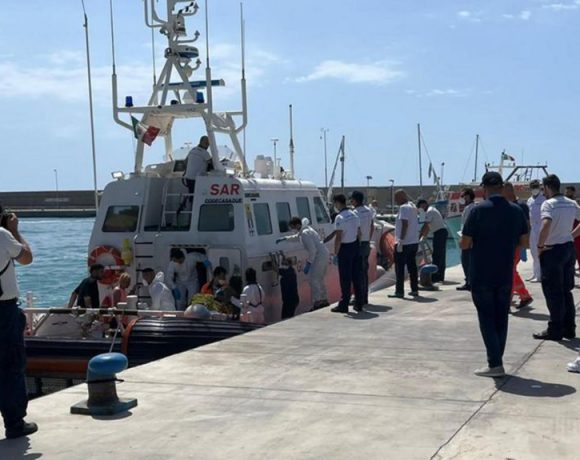
The captain of an aid ship recounted the dramatic rescue of migrants trapped in the cargo hold of a sinking boat off the coast of Italy. Ingo Veert, captain of the RESQSHIP aid vessel, shared on BBC’s Today programme how his crew used axes and hammers to save two men from below deck after initially rescuing 50 migrants from the deck of the distressed boat near Lampedusa. Sadly, 10 men were found dead below deck.
Another 64 migrants are reported missing at sea after a second vessel sank near Calabria, approximately 125 miles off the Italian coast. Of the 12 survivors from this incident, one died after reaching shore, as confirmed by the Italian coastguard.
The survivors of the Lampedusa incident were handed over to the Italian coastguard on Monday morning, while the deceased were being transported to the island, according to RESQSHIP. The migrants had departed from Libya and Turkey, each paying around $3,500 (£2,759) for the journey, as reported by Ansa news agency.
Captain Veert, who commands the Nadir rescue ship, recounted receiving the first distress call at 01:30 local time about an overloaded migrant boat. By 03:00, his crew reached the sinking vessel, where they found water flooding in and people in a state of panic. The crew distributed life jackets and used axes and hammers to break through the deck to rescue two trapped men, one of whom had a dangerously low body temperature of 32°C. Veert described the survivors as very young men, aged between 18 and 25, from Syria, Egypt, Pakistan, and Bangladesh, according to UN agencies.
In the separate Calabria incident, aid agencies reported that many of the missing are children, with at least 26 among the unaccounted for. Shakilla Mohammadi of MSF relayed survivors’ accounts indicating that 66 people, including entire families from Afghanistan, were missing. These families had left Turkey eight days prior, endured several days taking on water, and lacked life vests. Some vessels had passed without offering assistance.
The Mediterranean remains the deadliest migration route globally, with over 23,500 migrants dead or missing since 2014, according to UN data.
Picture Courtesy: Google/images are subject to copyright

